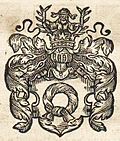Top Qs
Timeline
Chat
Perspective
Nałęcz coat of arms
Polish coat of arms From Wikipedia, the free encyclopedia
Remove ads
Nałęcz (Polish pronunciation: [ˈnawɛnt͡ʂ]) is a Polish coat of arms. It was used by associated szlachta families in the Kingdom of Poland (see Kingdom of Poland (1320–1385), and Kingdom of Poland (1385–1569)) and the Polish–Lithuanian Commonwealth (1569–1795).
You can help expand this article with text translated from the corresponding article in Polish. (December 2021) Click [show] for important translation instructions.
|
Remove ads
History
Nałęcz is a Polish coat of arms from the 12th century (like the Abdank, Leliwa, Radwan, and Bogorya coats of arms) that represented unity and harmony. It was used by the Gembiccy, Ostrorogowie, Szamotulscy, Chełmicki, Czarnkowscy, Slizewicz, Raczyńscy, Raczkowski, Dworniccy, Sadowski, Łowińscy, Grąbczewscy and other families. It is traditionally described as a silver shawl, tied, on a red background. Most versions had the shawl tied downwards; some were tied upwards. Some families showed the woman at the top blindfolded. Earlier versions and some modern ones depict the shawl untied. The shawl is similar in shape to the Teutonic image of Rune Othila, the Rune of a Fatherland.
The Nałęcz arms were initially connected with Greater Poland. The Nałęcze were accused of murdering Przemysł II in 1296. They also allied with Brandenburg against Władysław I Łokietek, and after the death of Louis I of Hungary waged war against the Grzymalites, attempting to put Ziemowit III of Masovia forcibly on the throne of Poland.
The best-known Poles who bore these arms were Joseph Conrad (Korzeniowski) and Sędziwój Ostroróg. A Nałęcz relief is on the Guard House building in Poznań.
Remove ads
Blazon
In heraldic English, the shield may be blazoned: Gules the Nałęcz shawl circled and knotted Argent.
Notable bearers
Notable bearers of this coat of arms have included:
- Józef Karol Konrad Chełmicki
- Kazimierz Franciszek Czarnkowski
- Adam Sędziwój Czarnkowski
- Benedykt Dybowski
- Apollo Korzeniowski
- Joseph Conrad Korzeniowski
- House of Małachowski
- Fryderyk Józef Moszyński
- Mikołaj Ostroróg
- Edward Raczyński (1786–1845)
- Edward Aleksander Raczyński
- Edward Bernard Raczyński
- Józef Sosnowski
Gallery
Summarize
Perspective
Standard variations
- Coat of arms of Stanisław Bartoloni, 1589
- Coat of arms of Dybowski family
- Coat of arms of Felsztyński family (1780)
- Coat of arms of Gostomski family
- Coat of arms of Korth vel Kort family
- Coat of arms of Kunowski family
- Coat of arms of Mikołaj Łączyński, 1580
- Coat of arms of Dobrogost Miliński, 1570
- Coat of arms of Gołyszewski and Morawski family
- Nałęcz II
- Nałęcz III
- Nałęcz IV
- Nałęcz V
- Coat of arms of Andrzej Strykowski, 1565 and Jan and Stanisła Niczów, 1578
- Coat of arms of Nowosielecki family
- Coat of arms of Odachowski family
- Coat of arms of Counts Ostroróg
- Coat of arms of Tomasz Pirawski, 17th century
- Coat of arms of Rostworowski family
- Coat of arms of Szawłowski family
- Coat of arms of Tański family
- Coat of arms of Jan Węgier, 1613
- Coat of arms of Woropaj family
- Coat of arms of Maciej Żądłowski, 1565
- Coat of arms of Żychliński family.
- Coat of arms of Morawski family.
Aristocratic variations
- Coat of arms of Counts Gorzeński family
- Coat of arms of Counts Kęszycki, Łączyński and Małachowski
- Coat of arms of Count Stanisław Małachowski
- Coat of arms of Counts Moszczeński
- Coat of arms of Counts Moszczeński.
- Coat of arms of Counts Ostrorog
- Coat of arms of Counts Raczyński
Other
- Nałecz coat of arms of Stanisław Slawieński in his burial monument inside Gniezno Cathedral (c. 1661)
- Nałęcz coat of arms of Kazimierz Raczyński, detail of Guardhouse in Poznań
- The Nałęcz Flag
- Medieval version of Nałecz coat of arms according to the Gelre Armorial
- A silver ring belonging to the Kalitvianski (Kalitwiński) family with an embossed Nałęcz coat of arms, manufactured in the XIX century in the Russian Empire.
- Coat of arms of the Polish President Stanisław Wojciechowski as Knight of the Order of the Elephant (1923). The Chapel of the Order of the Elephant, Frederiksborg Castle, Hillerød (Denmark).
- Dobrogost z Nowego Dworu, Archbishop of Gniezno
- Armorial Toison d'Or
- Nałęcz coat of arms by Bartłomiej Paprocki published in "Gniazdo cnoty.." (1578)
Remove ads
See also
Bibliography
- Juliusz Karol Ostrowski: Księga herbowa rodów polskich. T. 1-2. Warszawa: Główny skład księgarnia antykwarska B. Bolcewicza, 1897.
- Adam Boniecki: Herbarz polski. Warszawa: skł. gł. Gebethner i Wolff, 1899.
- Franciszek Piekosiński: Heraldyka polska wieków średnich. Kraków: Akademia Umiejętności, 1899.
- Józef Szymański: Herbarz średniowiecznego rycerstwa polskiego. Warszawa: PWN, 1993. ISBN 83-01-09797-3.
- Anna Wajs: Materiały genealogiczne, nobilitacje, indygenaty w zbiorach Archiwum Głównego Akt Dawnych w Warszawie. Warszawa: DiG, 2001. ISBN 83-7181-173-X.
- Alfred Znamierowski: Herbarz rodowy. Warszawa: Świat Książki, 2004. ISBN 83-7391-166-9.
- Tadeusz Gajl: Herbarz polski od średniowiecza do XX wieku : ponad 4500 herbów szlacheckich 37 tysięcy nazwisk 55 tysięcy rodów. L&L, 2007. ISBN 978-83-60597-10-1.
- Tadeusz Gajl: Nowy herbarz polski. 5 000 herbow + 50 000 nazwisk. Gdański Kantor Wydawniczy, 2016. ISBN 978-83-65387-05-9
Remove ads
References
External links
Wikiwand - on
Seamless Wikipedia browsing. On steroids.
Remove ads











































